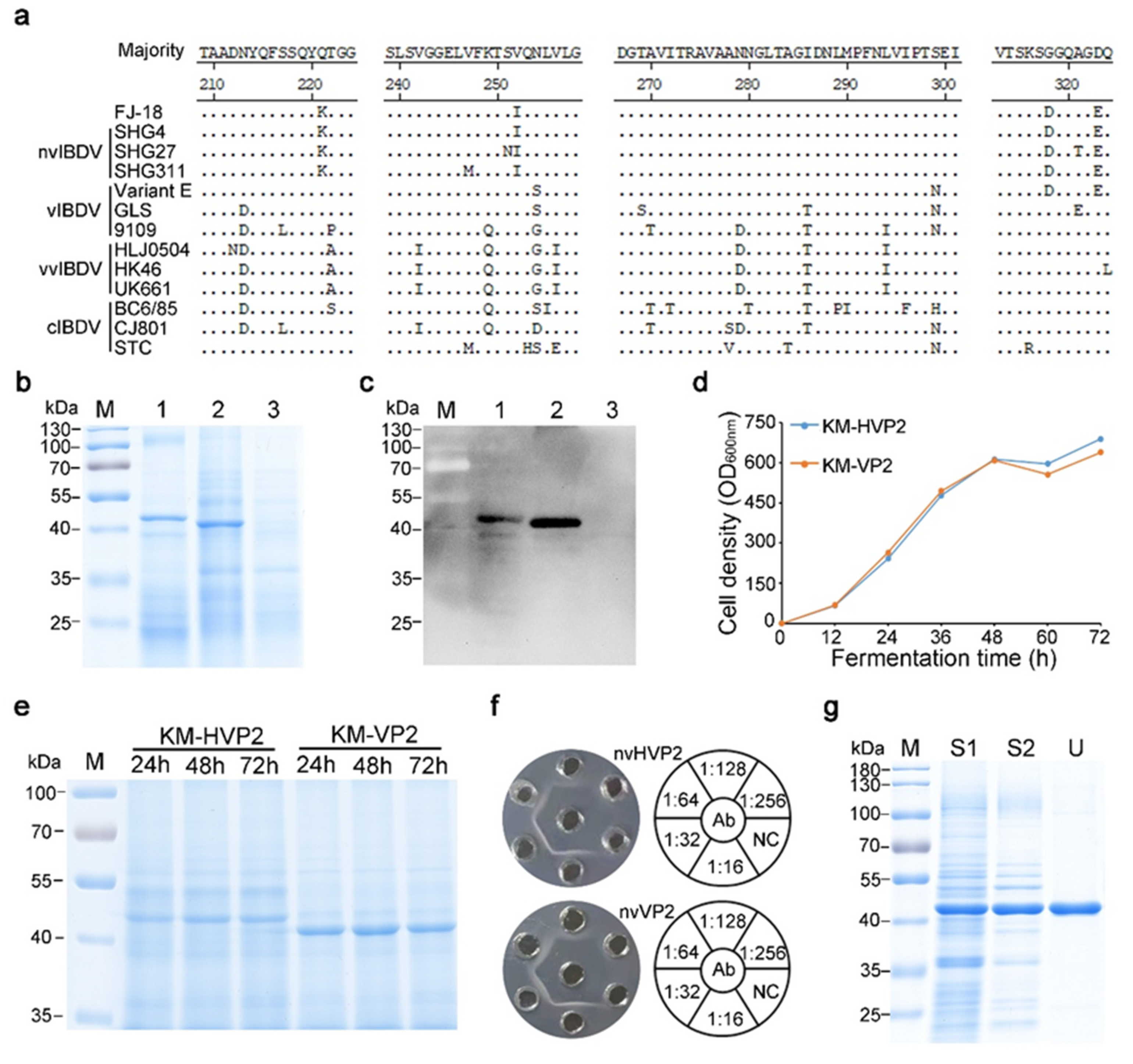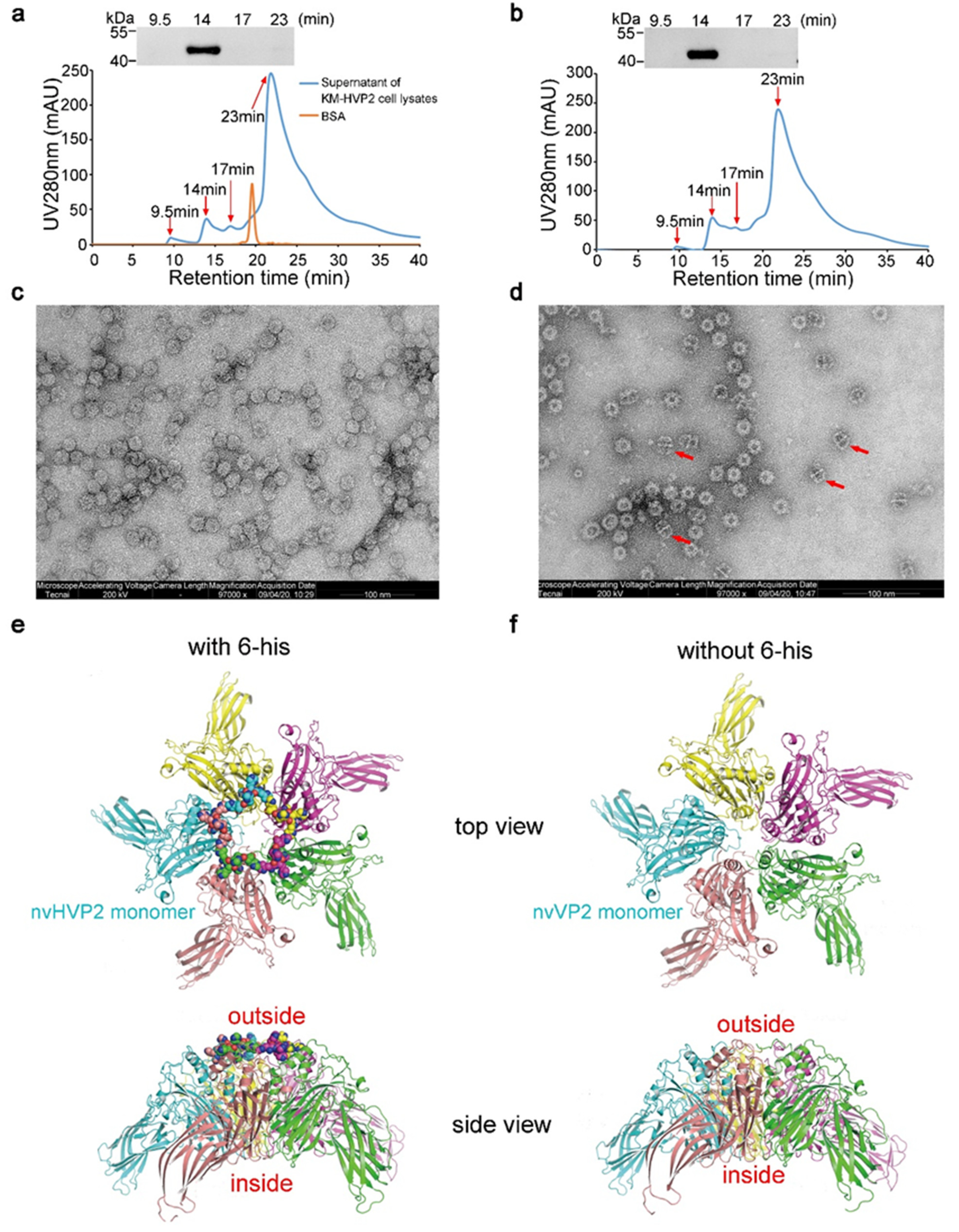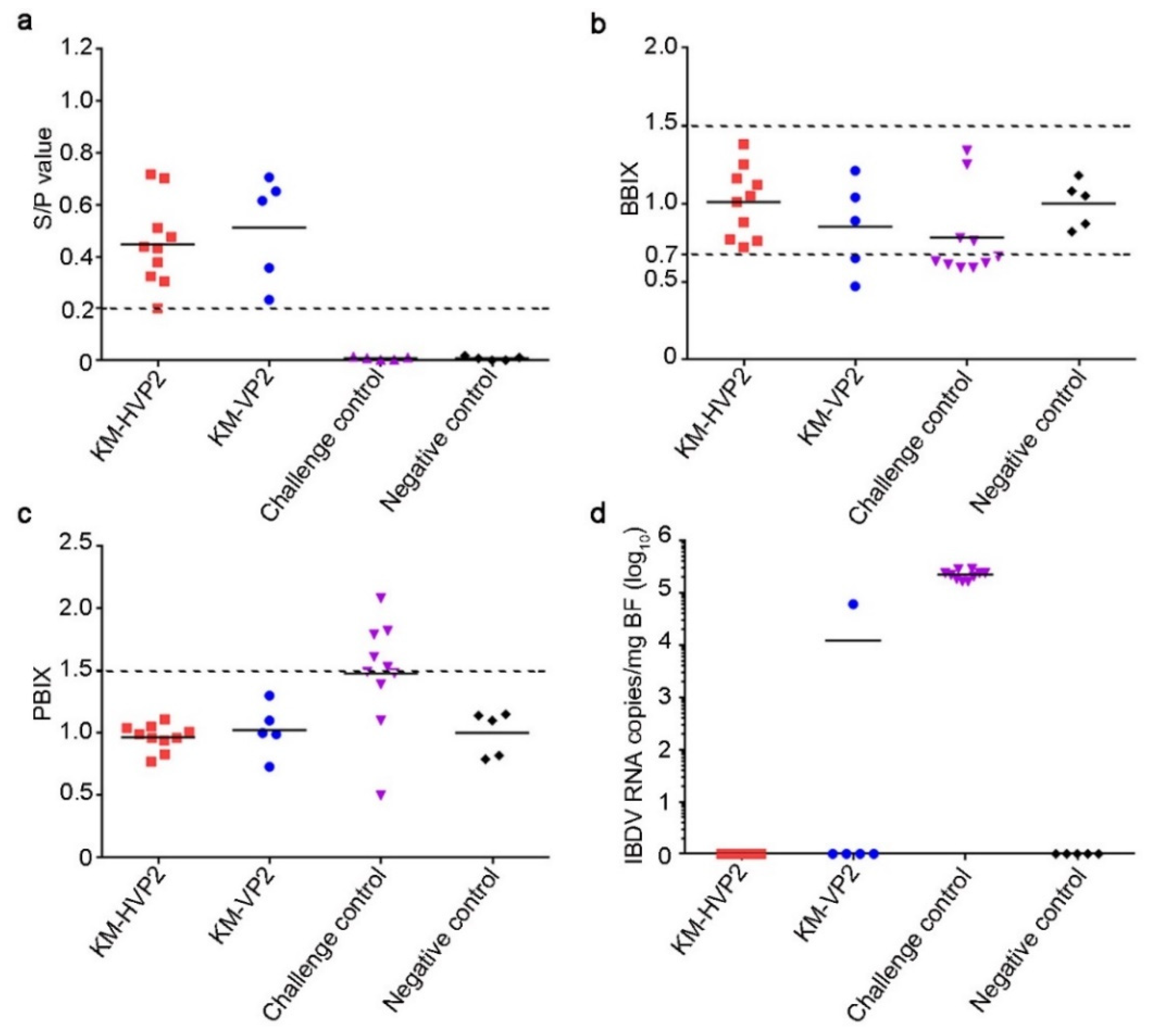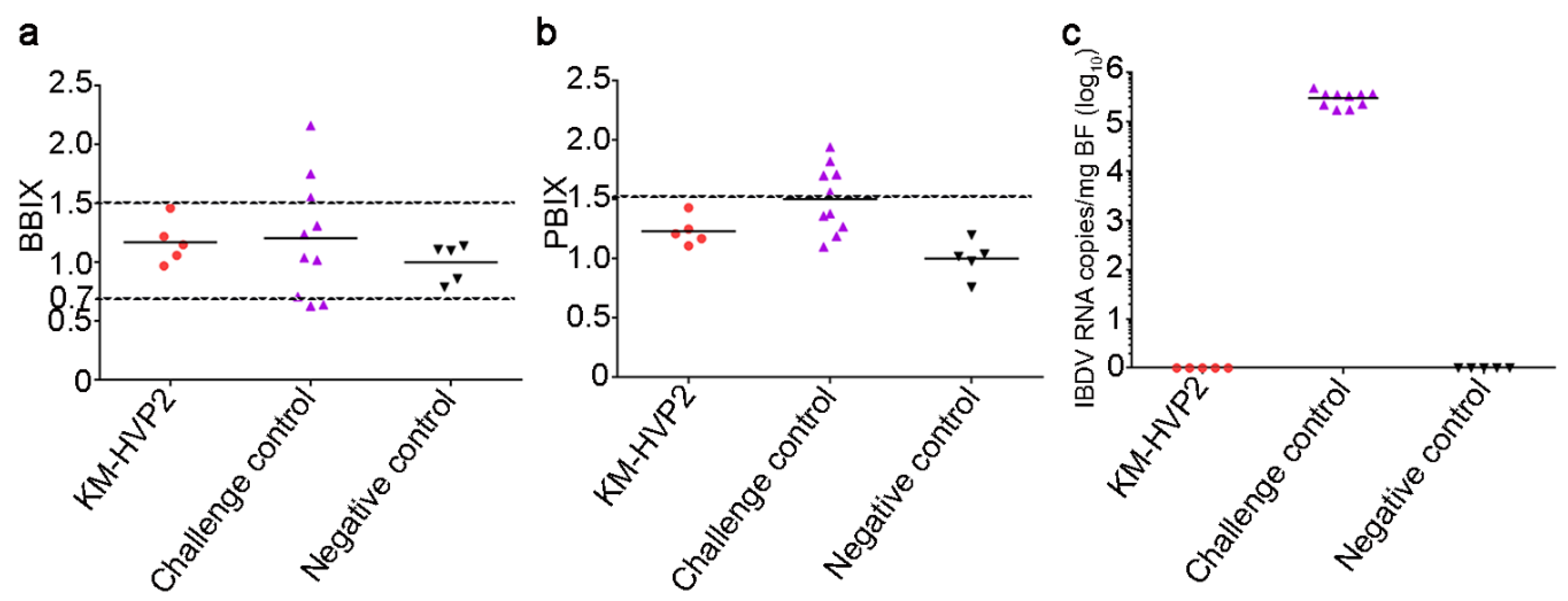A Single Vaccination of IBDV Subviral Particles Generated by Kluyveromyces marxianus Efficiently Protects Chickens against Novel Variant and Classical IBDV Strains
Abstract
:1. Introduction
2. Materials and Methods
2.1. Plasmids, Yeast Strains and Viruses
2.2. Construction of the Plasmids for Expression of nvVP2 and nvHVP2 Proteins in K. marxianus
2.3. Transformations of the Expression Plasmids into K. marxianus
2.4. SDS-PAGE and Western Blot Assays
2.5. Agarose Gel Precipitation (AGP) Analysis
2.6. High-Density Fermentation of the Recombinant K. marxianus Strains
2.7. Quantification of the VP2 Proteins in K. marxianus after 48 h Fermentation
2.8. SE-HPLC Detection and Transmission Electron Microscopy
2.9. Animal Experiments
2.10. Enzyme-Linked Immunosorbent Assay
2.11. Real-Time Quantitative PCR Analysis
2.12. Statistical Analysis
3. Results
3.1. Expression and Identification of the nvVP2 and nvHVP2 Proteins in K. marxianus
3.2. The nvVP2 and nvHVP2 Proteins Expressed in K. marxianus Self-Assemble to Form SVPs
3.3. Immunoprotections of the nvHVP2-SVPs and nvVP2-SVPs against IBDV Infection
4. Discussion
5. Conclusions
Author Contributions
Funding
Institutional Review Board Statement
Informed Consent Statement
Data Availability Statement
Conflicts of Interest
References
- Yang, H.; Ye, C.J. Reverse genetics approaches for live-attenuated vaccine development of infectious bursal disease virus. Curr. Opin. Virol. 2020, 44, 139–144. [Google Scholar] [CrossRef]
- Mcferran, J.B.; Mcnulty, M.S.; Mckillop, F.R.; Connor, T.J.; Mccracken, R.M.; Collins, D.S.; Allan, G.M. Isolation and Serological Studies with Infectious Bursal Disease Viruses from Fowl, Turkeys and Ducks—Demonstration of a 2nd Serotype. Avian Pathol. 1980, 9, 395–404. [Google Scholar] [CrossRef] [Green Version]
- Cosgrove, A.S. An Apparently New Disease of Chickens—Avian Nephrosis. Avian Dis. 1962, 6, 385. [Google Scholar] [CrossRef]
- Jackwood, D.H.; Saif, Y.M. Antigenic Diversity of Infectious Bursal Disease Viruses. Avian Dis. 1987, 31, 766–770. [Google Scholar] [CrossRef]
- Chettle, N.; Stuart, J.C.; Wyeth, P.J. Outbreak of Virulent Infectious Bursal Disease in East Anglia. Vet. Rec. 1989, 125, 271–272. [Google Scholar] [CrossRef]
- Fan, L.J.; Wu, T.T.; Hussain, A.; Gao, Y.L.; Zeng, X.Y.; Wang, Y.L.; Gao, L.; Li, K.; Wang, Y.Q.; Liu, C.J.; et al. Novel variant strains of infectious bursal disease virus isolated in China. Vet. Microbiol. 2019, 230, 212–220. [Google Scholar] [CrossRef]
- Fan, L.J.; Wu, T.T.; Wang, Y.L.; Hussain, A.; Jiang, N.; Gao, L.; Li, K.; Gao, Y.L.; Liu, C.J.; Cui, H.Y.; et al. Novel variants of infectious bursal disease virus can severely damage the bursa of fabricius of immunized chickens. Vet. Microbiol 2020, 240, 108507. [Google Scholar] [CrossRef] [PubMed]
- Xu, A.H.; Pei, Y.; Zhang, K.R.; Xue, J.; Ruan, S.F.; Zhang, G.Z. Phylogenetic analyses and pathogenicity of a variant infectious bursal disease virus strain isolated in China. Virus Res. 2020, 276, 197833. [Google Scholar] [CrossRef]
- Myint, O.; Suwanruengsri, M.; Araki, K.; Izzati, U.Z.; Pornthummawat, A.; Nueangphuet, P.; Fuke, N.; Hirai, T.; Jackwood, D.J.; Yamaguchi, R. Bursa atrophy at 28 days old caused by variant infectious bursal disease virus has a negative economic impact on broiler farms in Japan. Avian Pathol. 2021, 50, 6–17. [Google Scholar] [CrossRef]
- Thai, T.N.; Jang, I.; Kim, H.A.; Kim, H.S.; Kwon, Y.K.; Kim, H.R. Characterization of antigenic variant infectious bursal disease virus strains identified in South Korea. Avian Pathol. 2021, 50, 174–181. [Google Scholar] [CrossRef]
- Lauring, A.S.; Jones, J.O.; Andino, R. Rationalizing the development of live attenuated virus vaccines. Nat. Biotechnol. 2010, 28, 573–579. [Google Scholar] [CrossRef] [PubMed]
- Wei, Y.W.; Li, J.R.; Zheng, J.T.; Xu, H.; Li, L.; Yu, L. Genetic reassortment of infectious bursal disease virus in nature. Biochem. Biophys. Res. Commun. 2006, 350, 277–287. [Google Scholar] [CrossRef]
- Wei, Y.W.; Yu, X.P.; Zheng, J.T.; Chu, W.Y.; Xu, H.; Yu, X.M.; Yu, L. Reassortant infectious bursal disease virus isolated in China. Virus Res. 2008, 131, 279–282. [Google Scholar] [CrossRef] [PubMed]
- Cui, P.; Ma, S.J.; Zhang, Y.G.; Li, X.S.; Gao, X.Y.; Cui, B.A.; Chen, H.Y. Genomic sequence analysis of a new reassortant infectious bursal disease virus from commercial broiler flocks in central China. Arch. Virol. 2013, 158, 1973–1978. [Google Scholar] [CrossRef]
- Lu, Z.; Zhang, L.Z.; Wang, N.A.; Chen, Y.M.; Gao, L.; Wang, Y.Q.; Gao, H.L.; Gao, Y.L.; Li, K.; Qi, X.L.; et al. Naturally occurring reassortant infectious bursal disease virus in northern China. Virus Res. 2015, 203, 92–95. [Google Scholar] [CrossRef]
- Mazariegos, L.A.; Lukert, P.D.; Brown, J. Pathogenicity and Immunosuppressive Properties of Infectious Bursal Disease Intermediate Strains. Avian Dis. 1990, 34, 203–208. [Google Scholar] [CrossRef]
- Muller, H.; Mundt, E.; Eterradossi, N.; Islam, M.R. Current status of vaccines against infectious bursal disease. Avian Pathol. 2012, 41, 133–139. [Google Scholar] [CrossRef]
- Liu, F.X.; Wu, X.D.; Li, L.; Ge, S.Q.; Liu, Z.S.; Wang, Z.L. Virus-like particles: Promising platforms with characteristics of DIVA for veterinary vaccine design. Comp. Immunol. Microbiol. 2013, 36, 343–352. [Google Scholar] [CrossRef] [PubMed]
- Groeneveld, P.; Stouthamer, A.H.; Westerhoff, H.V. Super life—How and why ‘cell selection’ leads to the fastest-growing eukaryote. FEBS J. 2009, 276, 254–270. [Google Scholar] [CrossRef]
- Duan, J.K.; Yang, D.Q.; Chen, L.; Yu, Y.; Zhou, J.G.; Lu, H. Efficient production of porcine circovirus virus-like particles using the nonconventional yeast Kluyveromyces marxianus. Appl. Microbiol. Biotechnol. 2019, 103, 833–842. [Google Scholar] [CrossRef]
- Yang, D.Q.; Chen, L.; Duan, J.K.; Yu, Y.; Zhou, J.G.; Lu, H. Investigation of Kluyveromyces marxianus as a novel host for large-scale production of porcine parvovirus virus-like particles. Microb. Cell Factories 2021, 20, 24. [Google Scholar] [CrossRef]
- Liu, Y.; Mo, W.J.; Shi, T.F.; Wang, M.Z.; Zhou, J.G.; Yu, Y.; Yew, W.S.; Lu, H. Mutational Mtc6p attenuates autophagy and improves secretory expression of heterologous proteins in Kluyveromyces marxianus. Microb. Cell Factories 2018, 17, 144. [Google Scholar] [CrossRef]
- Gietz, R.D.; Schiestl, R.H. Large-scale high-efficiency yeast transformation using the LiAc/SS carrier DNA/PEG method. Nat. Protoc. 2007, 2, 38–41. [Google Scholar] [CrossRef]
- Hensing, M.; Vrouwenvelder, H.; Hellinga, C.; Baartmans, R.; Vandijken, H. Production of Extracellular Inulinase in High-Cell-Density Fed-Batch Cultures of Kluyveromyces-Marxianus. Appl. Microbiol. Biotechnol. 1994, 42, 516–521. [Google Scholar] [CrossRef]
- Gomez, E.; Cassani, M.F.; Lucero, M.S.; Parreno, V.; Zoth, S.C.; Berinstein, A. Development of diagnostic tools for IBDV detection using plants as bioreactors. Amb Express 2020, 10, 95. [Google Scholar] [CrossRef] [PubMed]
- Irigoyen, N.; Caston, J.R.; Rodriguez, J.F. Host Proteolytic Activity Is Necessary for Infectious Bursal Disease Virus Capsid Protein Assembly. J. Biol. Chem. 2012, 287, 24473–24482. [Google Scholar] [CrossRef] [Green Version]
- Galloux, M.; Libersou, S.; Morellet, N.; Bouaziz, S.; Da Costa, B.; Ouldali, M.; Lepault, J.; Delmas, B. Infectious bursal disease virus, a non-enveloped virus, possesses a capsid-associated peptide that deforms and perforates biological membranes. J. Biol. Chem. 2007, 282, 20774–20784. [Google Scholar] [CrossRef] [Green Version]
- Saugar, I.; Luque, D.; Ona, A.; Rodriguez, J.F.; Carrascosa, J.L.; Trus, B.L.; Caston, J.R. Structural polymorphism of the major capsid protein of a double-stranded RNA virus: An amphipathic alpha helix as a molecular switch. Structure 2005, 13, 1007–1017. [Google Scholar] [CrossRef] [Green Version]
- Saugar, I.; Irigoyen, N.; Luque, D.; Carrascosa, J.L.; Rodriguez, J.F.; Caston, J.R. Electrostatic Interactions between Capsid and Scaffolding Proteins Mediate the Structural Polymorphism of a Double-stranded RNA Virus. J. Biol. Chem. 2010, 285, 3643–3650. [Google Scholar] [CrossRef] [Green Version]
- He, X.M.; Wang, W.W.; Chen, G.; Jiao, P.T.; Ji, Z.H.; Yang, L.; Wei, P. Serological study reveal different antigenic IBDV strains prevalent in southern China during the years 2000-2017 and also the antigenic differences between the field strains and the commonly used vaccine strains. Vet. Microbiol. 2019, 239, 108458. [Google Scholar] [CrossRef] [PubMed]
- Wang, Y.L.; Jiang, N.; Fan, L.J.; Gao, L.; Li, K.; Gao, Y.L.; Niu, X.X.; Zhang, W.Y.; Cui, H.Y.; Liu, A.J.; et al. Development of a Viral-Like Particle Candidate Vaccine Against Novel Variant Infectious Bursal Disease Virus. Vaccines 2021, 9, 142. [Google Scholar] [CrossRef]
- Fan, L.J.; Wang, Y.L.; Jiang, N.; Gao, L.; Li, K.; Gao, Y.L.; Cui, H.Y.; Pan, Q.; Liu, C.J.; Zhang, Y.P. A reassortment vaccine candidate of the novel variant infectious bursal disease virus. Vet. Microbiol. 2020, 251, 108905. [Google Scholar] [CrossRef]
- Taghavian, O.; Spiegel, H.; Hauck, R.; Hafez, H.M.; Fischer, R.; Schillberg, S. Protective Oral Vaccination against Infectious bursal disease virus Using the Major Viral Antigenic Protein VP2 Produced in Pichia pastoris. PLoS ONE 2013, 8, e83210. [Google Scholar] [CrossRef]
- Wang, M.Y.; Kuo, Y.Y.; Lee, M.S.; Doong, S.R.; Ho, J.Y.; Lee, L.H. Self-assembly of the infectious bursal disease virus capsid protein, rVP2, expressed in insect cells and purification of immunogenic chimeric rVP2H particles by immobilized metal-ion affinity chromatography. Biotechnol. Bioeng. 2000, 67, 104–111. [Google Scholar] [CrossRef]
- Li, G.P.; Kuang, H.Y.; Guo, H.X.; Cai, L.S.; Chu, D.F.; Wang, X.; Hu, J.X.; Rong, J. Development of a recombinant VP2 vaccine for the prevention of novel variant strains of infectious bursal disease virus. Avian Pathol. 2020, 49, 557–571. [Google Scholar] [CrossRef]
- Kushnir, N.; Streatfield, S.J.; Yusibov, V. Virus-like particles as a highly efficient vaccine platform: Diversity of targets and production systems and advances in clinical development. Vaccine 2012, 31, 58–83. [Google Scholar] [CrossRef]
- Dalton, A.C.; Barton, W.A. Over-expression of secreted proteins from mammalian cell lines. Protein Sci. 2014, 23, 517–525. [Google Scholar] [CrossRef]
- Yamaji, H. Suitability and perspectives on using recombinant insect cells for the production of virus-like particles. Appl. Microbiol. Biotechnol. 2014, 98, 1963–1970. [Google Scholar] [CrossRef] [PubMed]
- Huang, X.F.; Wang, X.; Zhang, J.; Xia, N.S.; Zhao, Q.J. Escherichia coli-derived virus-like particles in vaccine development. Npj Vaccines 2017, 2, 3. [Google Scholar] [CrossRef] [Green Version]
- Lua, L.H.L.; Connors, N.K.; Sainsbury, F.; Chuan, Y.P.; Wibowo, N.; Middelberg, A.P.J. Bioengineering Virus-Like Particles as Vaccines. Biotechnol. Bioeng. 2014, 111, 425–440. [Google Scholar] [CrossRef]
- Kim, H.J.; Kim, H.J. Yeast as an expression system for producing virus-like particles: What factors do we need to consider? Lett. Appl. Microbiol. 2017, 64, 111–123. [Google Scholar] [CrossRef]
- Wang, M.; Pan, Q.; Lu, Z.; Li, K.; Gao, H.L.; Qi, X.L.; Gao, Y.L.; Wang, X.M. An optimized, highly efficient, self-assembled, subvirus-like particle of infectious bursal disease virus (IBDV). Vaccine 2016, 34, 3508–3514. [Google Scholar] [CrossRef]




| Groups | Bursa Atrophy/Edema | Spleen Edema | Gross Lesion in Bursa | IBDV in Bursa |
|---|---|---|---|---|
| KM-HVP2 | 0/10 | 0/10 | 0/10 | 0/10 |
| KM-VP2 | 2/5 | 0/5 | 0/5 | 1/5 |
| Challenge control | 6/10 | 5/10 | 10/10 | 10/10 |
| Negative control | 0/5 | 0/5 | 0/5 | 0/5 |
| Groups | Bursa Atrophy/Edema | Spleen Edema | Gross Lesion in Bursa | IBDV in Bursa |
|---|---|---|---|---|
| KM-HVP2 | 0/5 | 0/5 | 0/5 | 0/5 |
| Challenge control | 5/10 | 5/10 | 10/10 | 10/10 |
| Negative control | 0/5 | 0/5 | 0/5 | 0/5 |
Publisher’s Note: MDPI stays neutral with regard to jurisdictional claims in published maps and institutional affiliations. |
© 2021 by the authors. Licensee MDPI, Basel, Switzerland. This article is an open access article distributed under the terms and conditions of the Creative Commons Attribution (CC BY) license (https://creativecommons.org/licenses/by/4.0/).
Share and Cite
Yang, D.; Zhang, L.; Duan, J.; Huang, Q.; Yu, Y.; Zhou, J.; Lu, H. A Single Vaccination of IBDV Subviral Particles Generated by Kluyveromyces marxianus Efficiently Protects Chickens against Novel Variant and Classical IBDV Strains. Vaccines 2021, 9, 1443. https://doi.org/10.3390/vaccines9121443
Yang D, Zhang L, Duan J, Huang Q, Yu Y, Zhou J, Lu H. A Single Vaccination of IBDV Subviral Particles Generated by Kluyveromyces marxianus Efficiently Protects Chickens against Novel Variant and Classical IBDV Strains. Vaccines. 2021; 9(12):1443. https://doi.org/10.3390/vaccines9121443
Chicago/Turabian StyleYang, Deqiang, Lixia Zhang, Jinkun Duan, Qiang Huang, Yao Yu, Jungang Zhou, and Hong Lu. 2021. "A Single Vaccination of IBDV Subviral Particles Generated by Kluyveromyces marxianus Efficiently Protects Chickens against Novel Variant and Classical IBDV Strains" Vaccines 9, no. 12: 1443. https://doi.org/10.3390/vaccines9121443
APA StyleYang, D., Zhang, L., Duan, J., Huang, Q., Yu, Y., Zhou, J., & Lu, H. (2021). A Single Vaccination of IBDV Subviral Particles Generated by Kluyveromyces marxianus Efficiently Protects Chickens against Novel Variant and Classical IBDV Strains. Vaccines, 9(12), 1443. https://doi.org/10.3390/vaccines9121443






